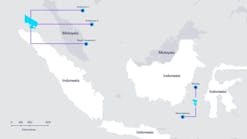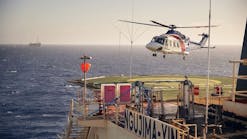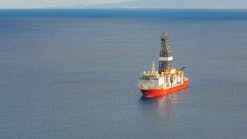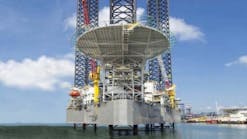Leonard LeBlanc
Houston
- This schematic shows an air vibrating system atop a cement slurry to improve the hydraulic seal between casing and the formation. Each 10 second pulse results in a 3-ft vertical movement of the slurry.
Monohull ascendancy
Thirty years ago, exploration drilling units broke free of seabed support and became mobile. In recent years, it's been production's turn. Are such conventional structures as steel spaceframe jacket platforms and concrete gravity structures doomed?
Maybe not, but we're getting there. The industry is marching steadily toward the compliancy end of the motion response spectrum and away from restraint. With two exceptions, most fields can be produced more economically with moveable structures, meaning monohull and semisubmersible floaters, jackup production units, tension-leg platforms, spars, etc.
In shallow water, there are no competitors to conventional steel spaceframe and monoleg jackets. And where ice floes are involved (not icebergs), fixed concrete gravity structures are more economic because production stoppage remains a large liability with mobile systems. At one time, this was the case for the North Sea, but no longer.
Monohull floaters are squeezing out semisubmersible units as the production technology of choice in the North Sea, because the hulls are widely available or easy to build, and the mooring, swivel, and product transfer technology hurdles have been overcome. Phillips Petroleum's Knut Åm recently predicted that 33% of new development investment in the North Sea will go to subsea equipment, 29% to production vessels and equipment, 24% to mobile platforms, and only 10% to conventional platforms.
Two recent fabrication orders provide examples of how both production and drilling technologists view the future:
- Mobil and Oceaneering are converting a very large crude carrier with a length of over 1,100 ft and capacity to store 1.8 million bbl to produce from the Zafiro Field off West Africa. Given the limited knowledge about the field at this time, the tanker will act an early production system, but it has the reserve to operate long term if needed. The $70 million conversion cost for a vessel that can be used on other fields afterward leaves room for error on field estimation.
- Sonat Offshore is contracting for a drillship that will be 850 ft long and twice as wide as existing drillships. Not only will the vessel's size make it extremely weather-resistant and capable of drilling in the deepest water, but it will allow multiple functions on deck, significantly cutting back on drilling, completion, and field hookup time (see page 34).
Both monohull units will provide a huge amount of reserve and flexibility, in terms of on-site operations as well as field development timing. While maintaining flexibility, the vessels provide for the bigger prize - collapsing the time between exploration well spud-in and initial production.
Green water loading, structural fatigue subject of study
The trend to increased use of tankers for floating production and storage operations in the North Sea has forced operators there to take a closer look at two problems specific to tankers: green water loading (waves on the deck) and structural fatigue.
Green water loading upon a hull constrained by a turret or bow mooring and loading system presents a different set of forces than free motion response. As an alternative to simply reinforcing the hull, The Marine Research Institute in the Netherlands (Wageningen) is studying varying bow shapes to prevent shipping the water in the first place. However, alternative shapes have impacts on drift, mooring, and deck processes, and this will also be studied.
The institute, along with Bluewater Marine, is also compiling a database to monitor fatigue loads and structural responses on floating monohull production systems and develop analytical tools to assess fatigue in new systems.
Air pulse vibrations help consolidate cement slurries
A process of vibrating cement slurries before they harden in the annulus apparently helps improve the hydraulic seal between the casing and the formation. The process would help prevent gas migration. The Gas Research Institute and Texaco E&P Technology are conducting further tests to evaluate the process in deep wells.
The two concluded that migration paths and loss of bond and sealing develop in the few hours that it takes for a slurry to shift from a liquid to a gel, and then into a solid. As the slurry shifts to the gel state, the volume shrinks, allowing an influx of gas from the formation.
Pressurizing the annulus helps prevent gas invasion of the annulus, but researchers found there was little effect on shrinkage. What did work was vibrating the gelling cement.
The most effective method of vibration was to apply air pressure pulsing to the cement slurry at the surface. An air pulse generator reciprocated the slurry three ft vertically. The pulse width was five seconds and the cycle was repeated every 10 seconds.
The three ft vertical displacement fell off to zero at the bottom, where setting of the cement was rapid as a result of higher temperatures. As the hardening cement's compressive strength reached equilibrium with the 100 lb psi applied at the surface, the vibration was decoupled. As the hardening action moved upwards in the annulus, so did the decoupling.
Reference: Haberman, J. "Sealing Gas Zones by Vibrating Cement Slurries," GasTIPS, Spring, 1966.
Petrobras uses taut mooring synthetics
Petrobras will be the first operator to permanently moor production units with synthetic fiber ropes. The semisubmersible floating production platforms P-19 (Stawinner) and P-26 (Illiad), will be moored in 2500 ft and 3250 ft water depths, respectively.
Each floating unit will use a 16 polyester tethers in a taut-moored arrangement. Each 21-in. diameter tether will have a 700-ton breaking strength. Marlow Ropes (Hailsham, UK) will supply the tethers.
Copyright 1996 Offshore. All Rights Reserved.




